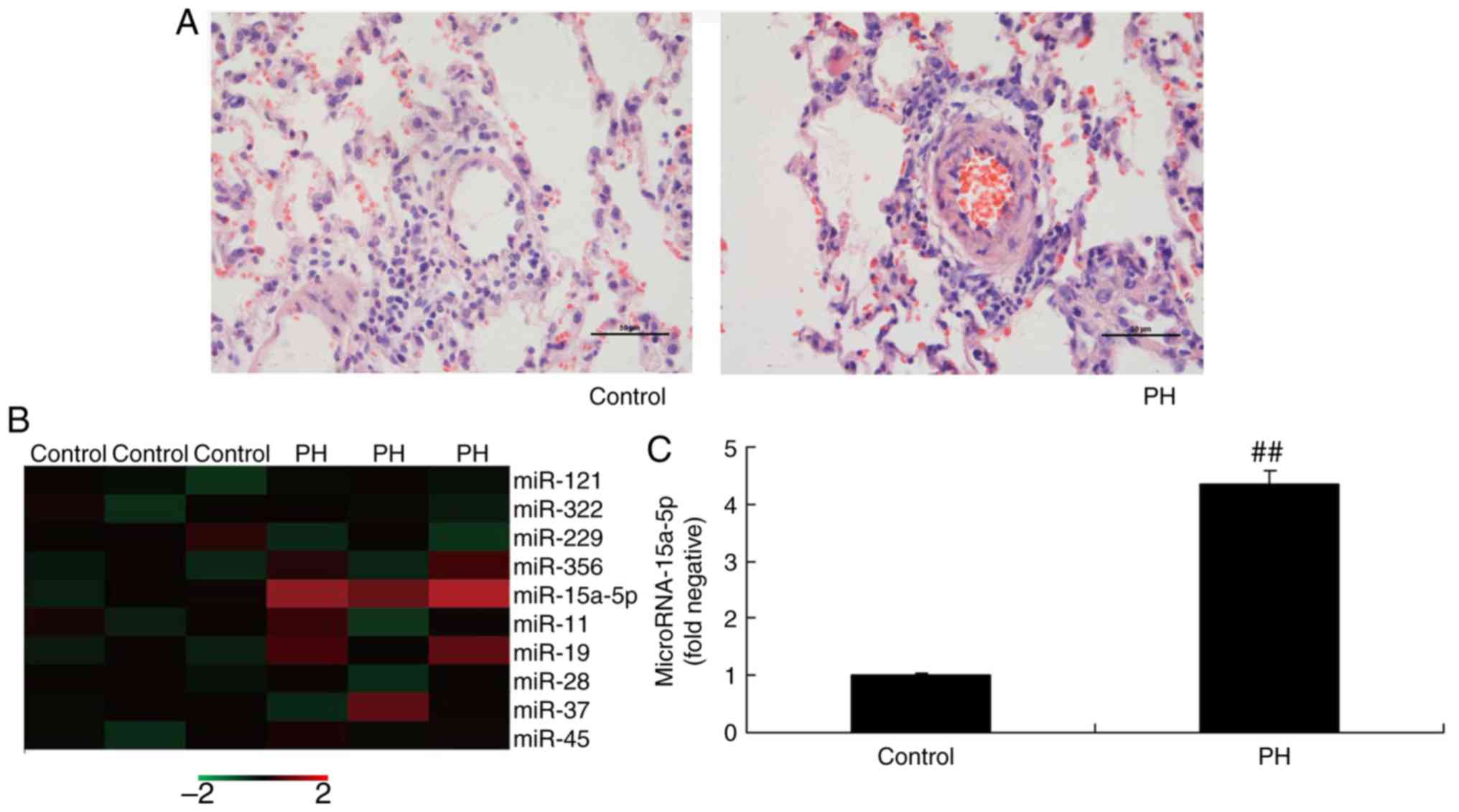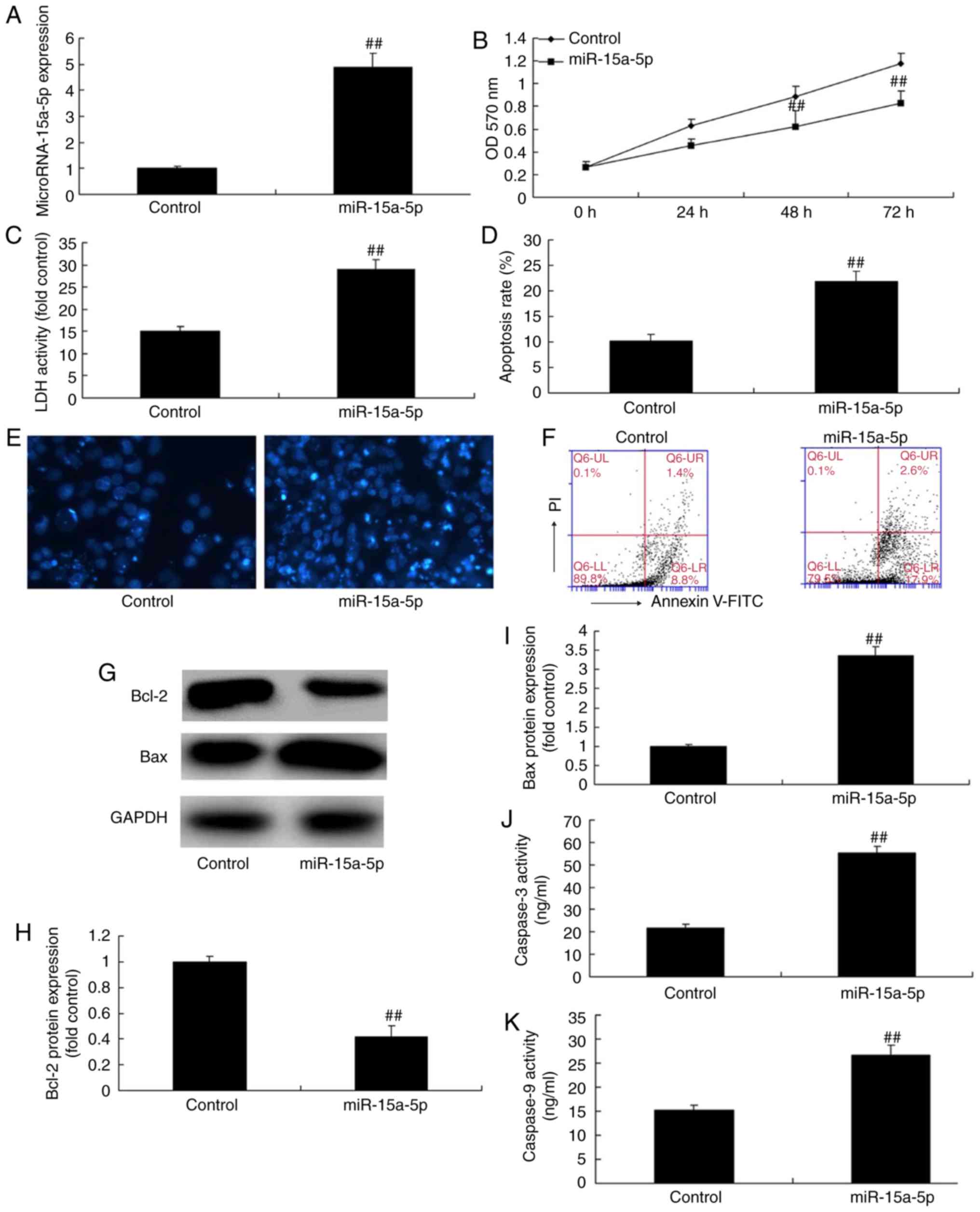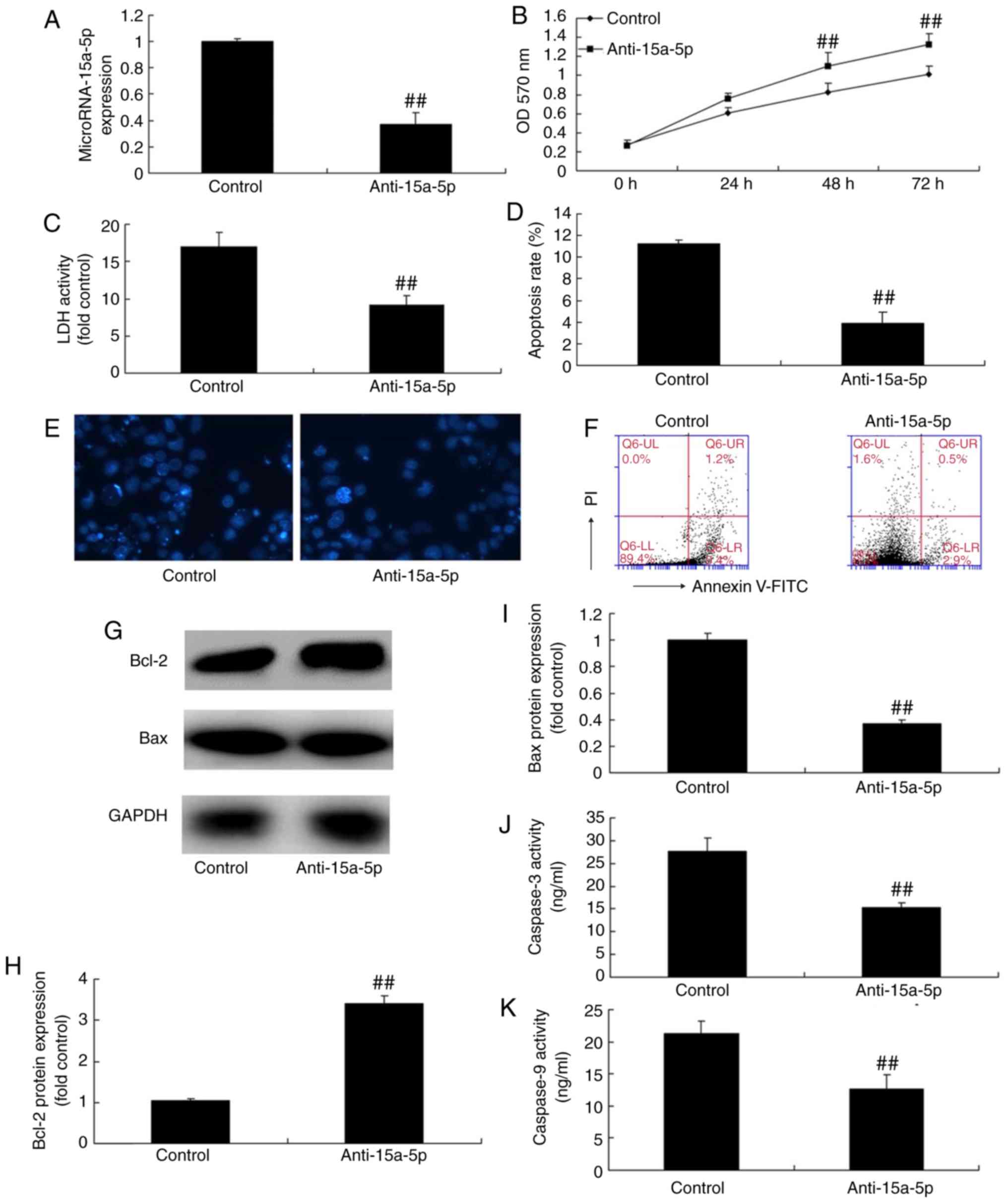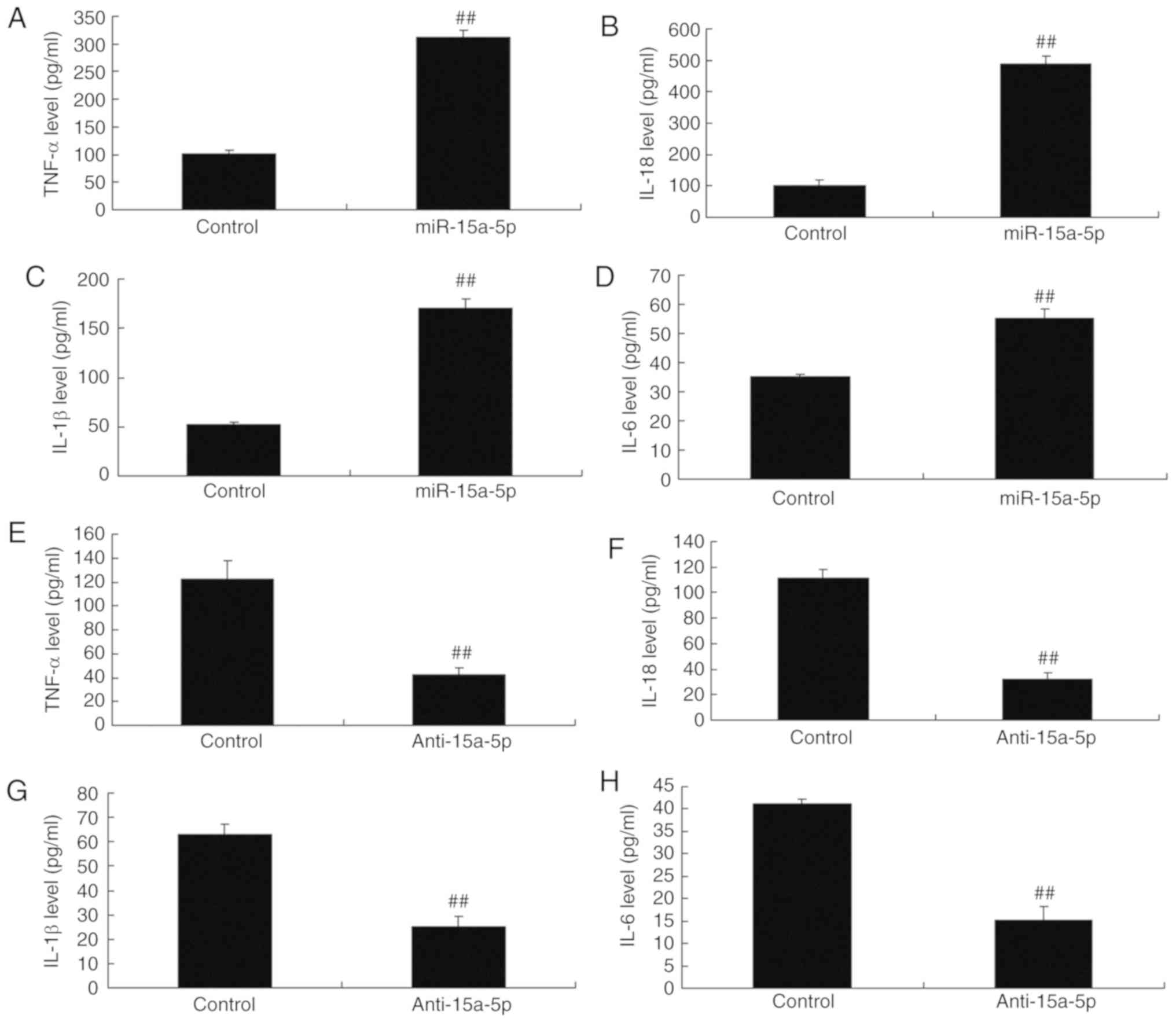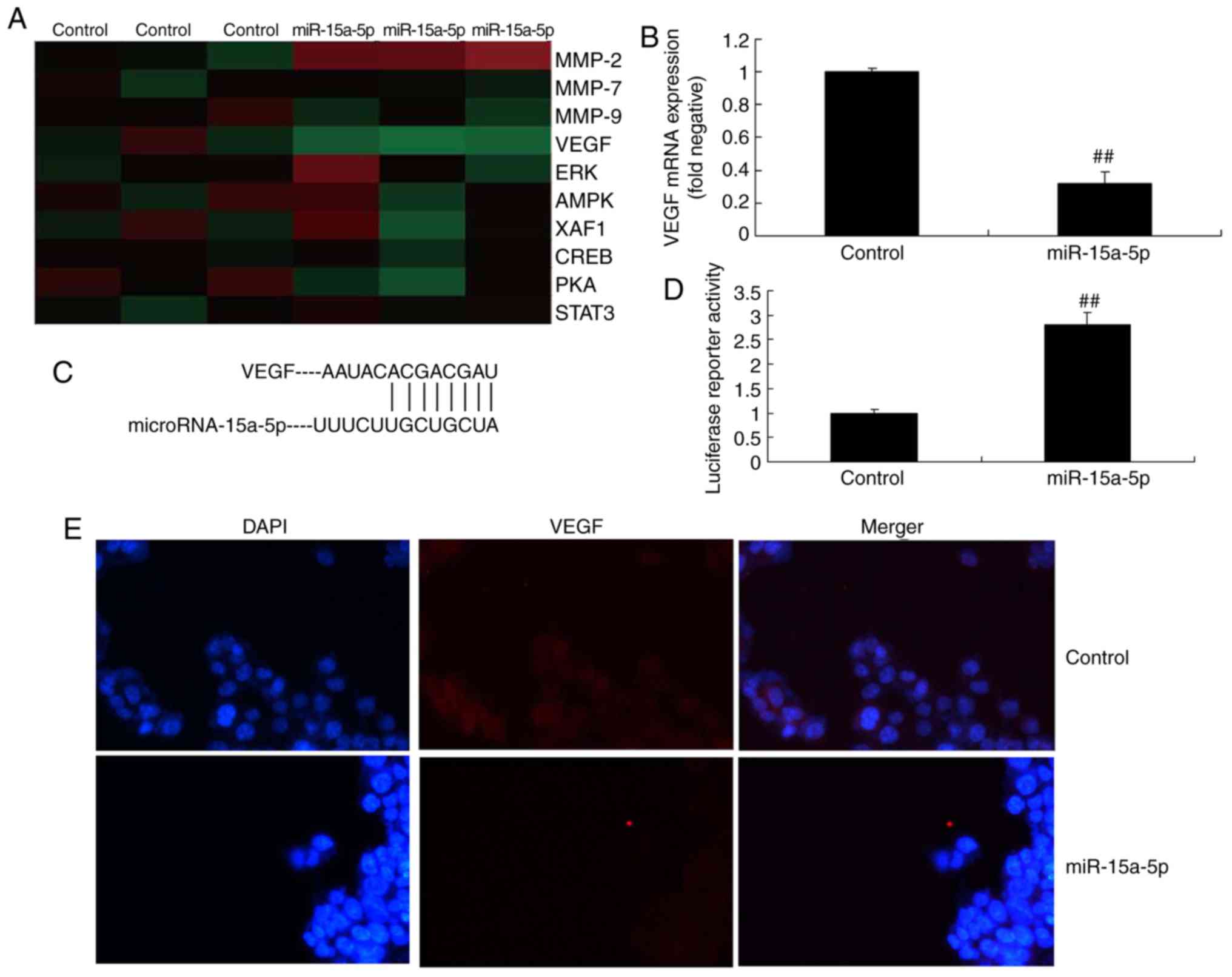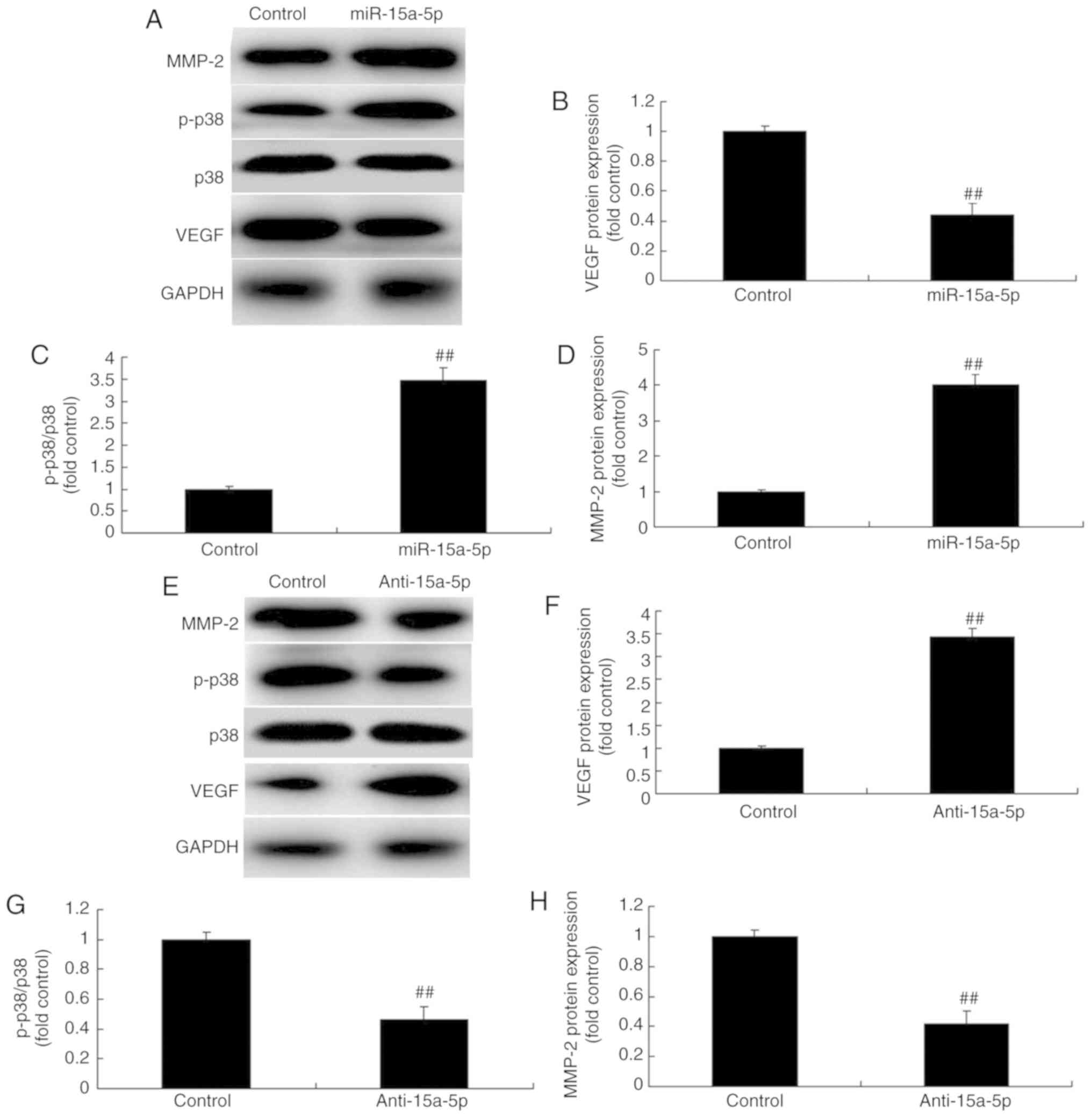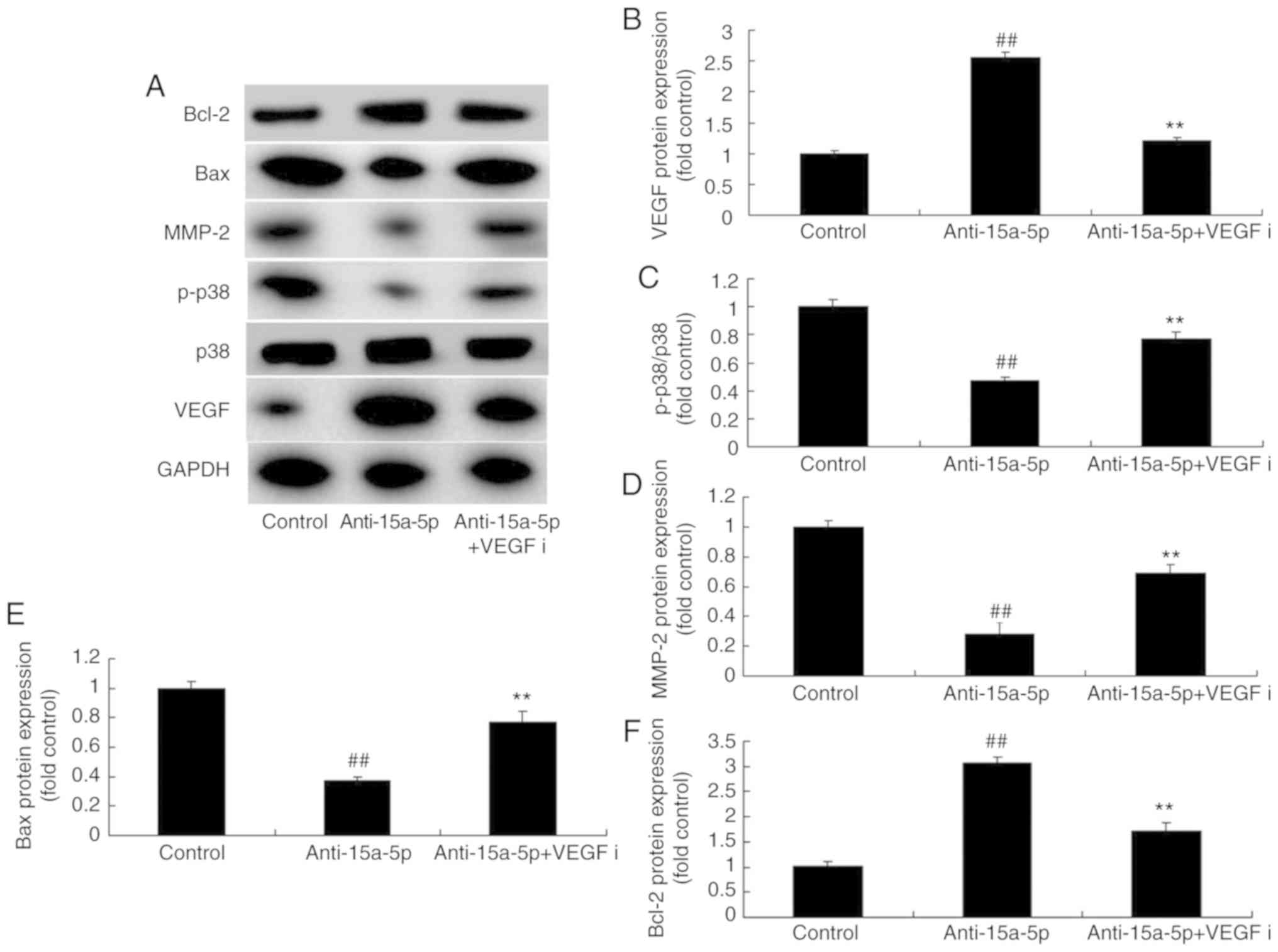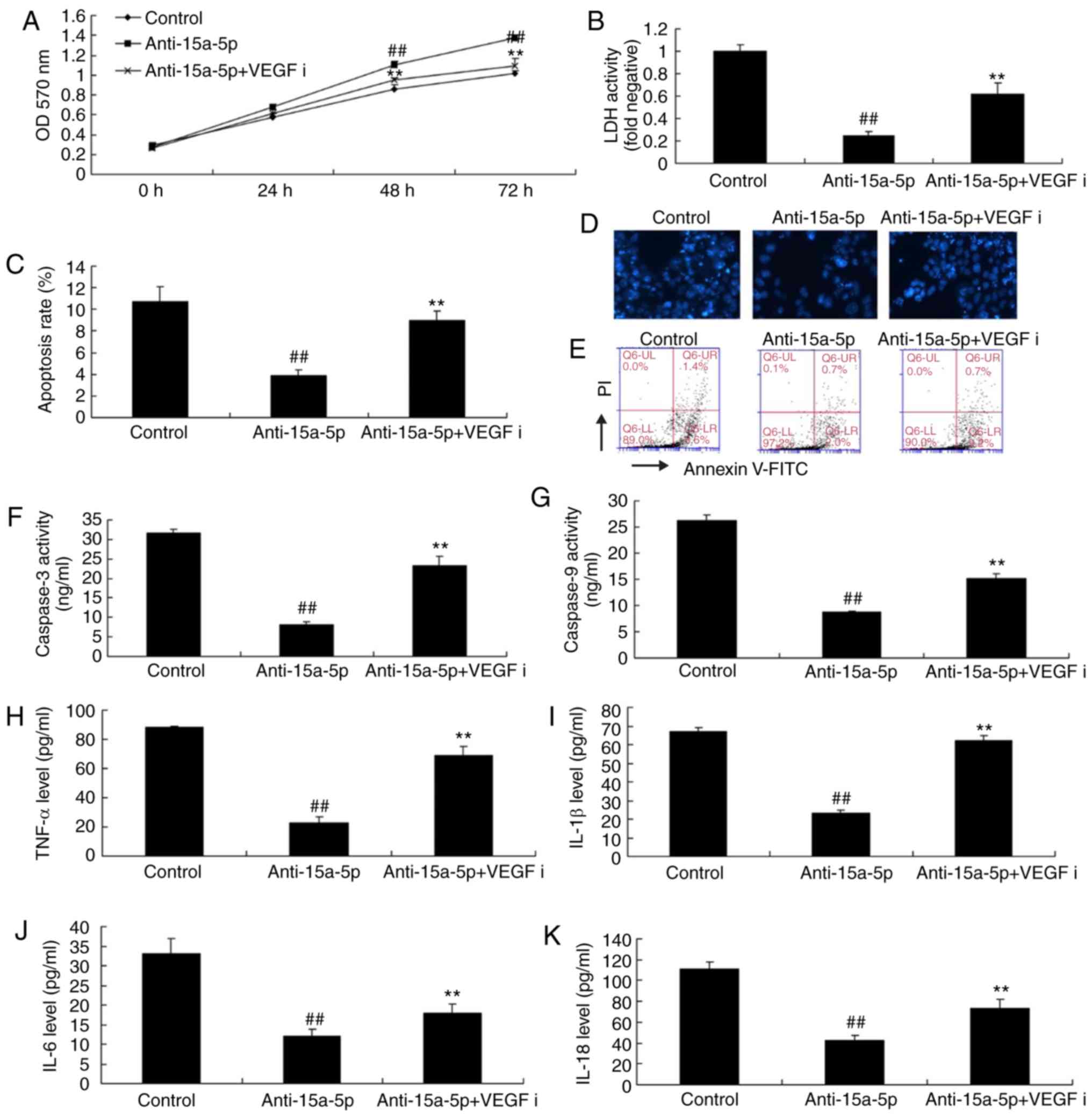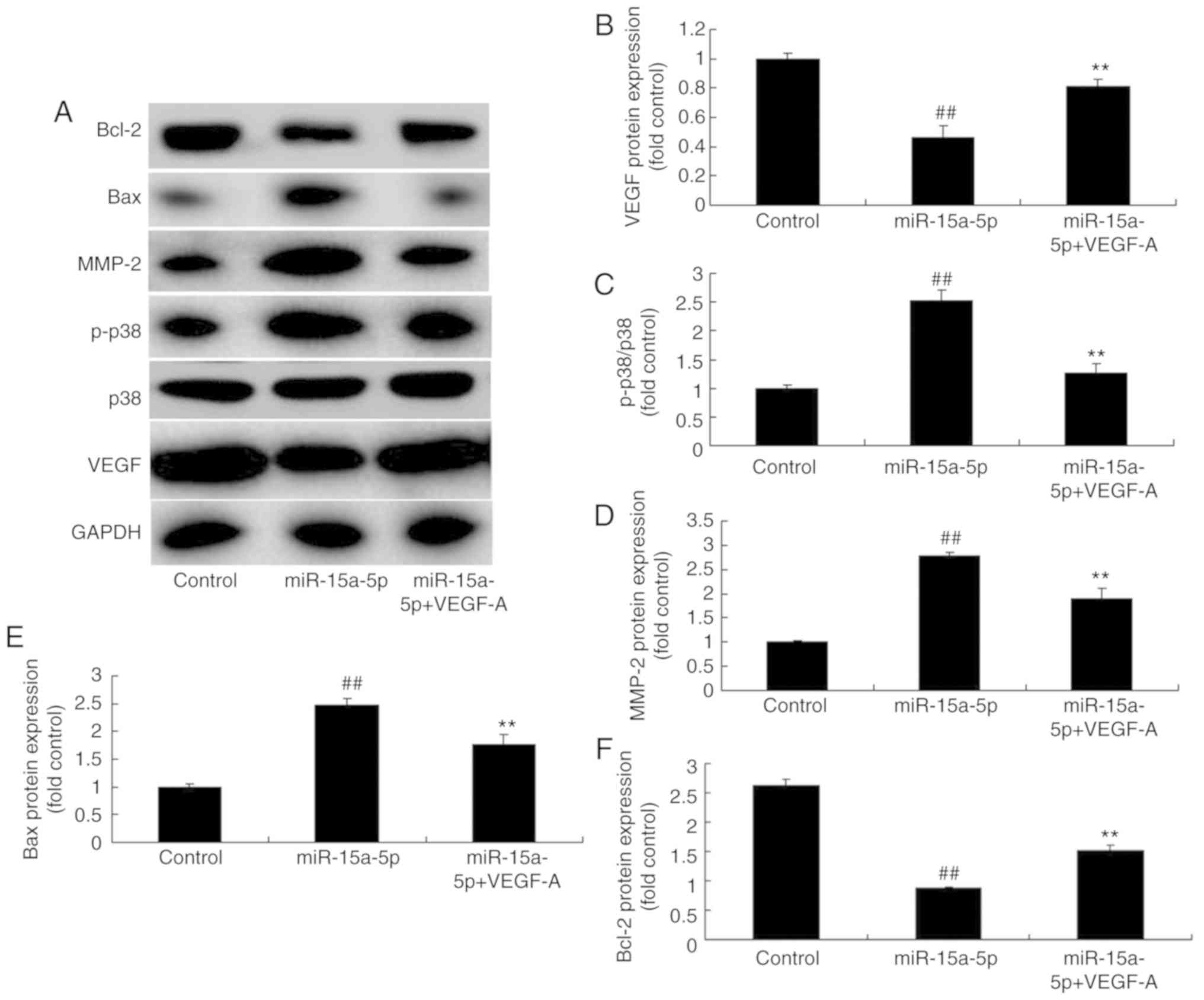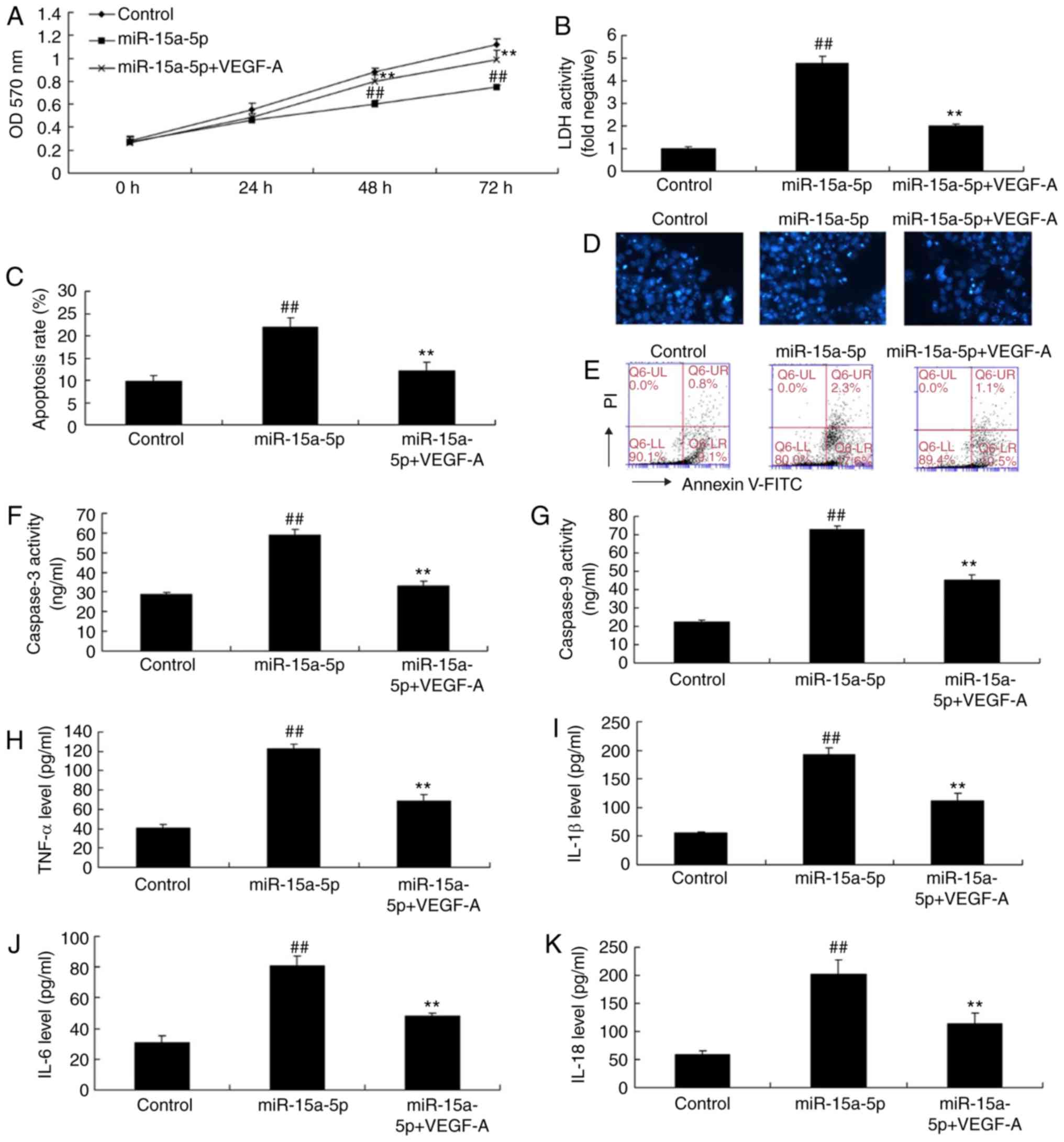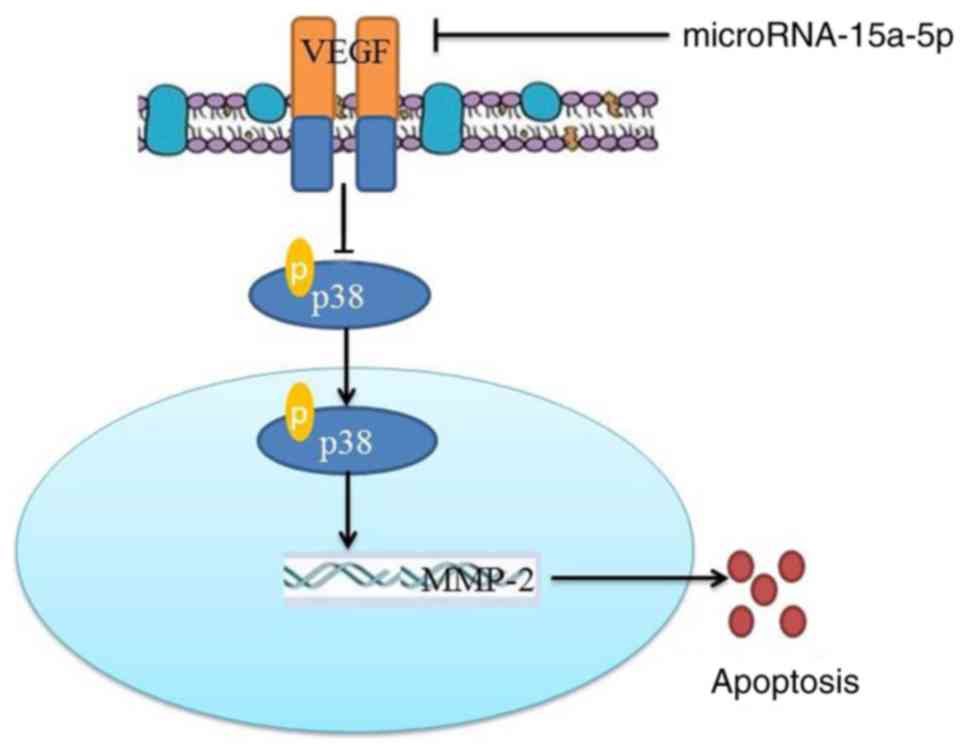MicroRNA‑15a‑5p induces pulmonary artery smooth muscle cell apoptosis in a pulmonary arterial hypertension model via the VEGF/p38/MMP‑2 signaling pathway
- Authors:
- Published online on: December 18, 2019 https://doi.org/10.3892/ijmm.2019.4434
- Pages: 461-474
-
Copyright: © Zhang et al. This is an open access article distributed under the terms of Creative Commons Attribution License.
Abstract
Introduction
Pulmonary hypertension (PH), a progressive disease of various origins, is associated with pulmonary vascular remodeling and results in right heart dysfunction (1). According to the classification of the World Health Organization (2), pulmonary arterial hypertension (PAH) is a major type of PH. The main histopathological manifestations of PAH include vasoconstriction, endothelial cell proliferation and fibrosis, smooth muscle cell proliferation and thrombosis in small pulmonary arteries, which lead to the elevation of pulmonary vascular resistance and, consequently, result in PAH (3,4). Despite the development and application of new types of anti-PAH drugs, the clinical management of PAH patients represents a challenge, and this condition is associated with high mortality rates and markedly poor prognosis (5). Long-term PAH induces vascular remodeling, thus resulting in pulmonary vascular complications, which are a direct cause of death.
Cell apoptosis is a type of cell death process, which is induced by the prestored cell death program and is triggered by factors in vivo and in vitro (6); it is also referred to as programmed cell death. Apoptosis is characterized by relatively intact cell membrane and organelles, cell shrinkage and karyopyknosis in terms of morphology (7). This phenomenon is completely different from the comprehensive cell structural dissolution and destruction that occur in necrosis. The early changes caused by apoptosis occur on the cell membrane surface. The balance between cell proliferation and apoptosis is an important mechanism for maintaining the functional integrity of the organs (8).
MicroRNAs (miRNAs) are a class of small, endogenous, non-coding RNA molecules, 21-22 nucleotides in length. These small miRNAs target one or more mRNAs, and they regulate gene expression through inhibiting target mRNAs or suppressing their translation (9). miRNAs are derived from non-coding RNAs. They transform from pri-miRNAs to pre-miRNAs (9). In addition, they produce functionally mature miRNAs through the Dicer complex. The mature miRNA can bind with the RNA-induced silencing complex (10) and exhibits complementary binding with target mRNAs; therefore, it can inhibit or prevent their translation. Several studies have indicated that miRNAs are involved in almost all pathophysiological processes, including embryonic development, cell differentiation, angiogenesis, tumor formation and damage repair (11).
Vascular endothelial growth factor (VEGF) is the most important factor for pulmonary vascular development (12). VEGF is a cytokine that remains multifunctional during the entire embryonic, fetal and postnatal periods. In addition, VEGF is the most potent and critical regulatory factor of pulmonary vascular growth and maintenance, and it is involved in the development of hyperoxia-induced lung injury in newborns. VEGF mainly acts during the early stage of pulmonary angiogenesis (13); it can promote the formation of an original vascular network. The expression levels of VEGF and its receptors (VEGFRs) are increased in the lung tissue under chronic hypoxic conditions and in lung tissue samples following monocrotaline (MCT)-induced lung injury (14). The upregulated expression of VEGF and VEGFR1-2 has been associated with pulmonary arteriolar endothelial and smooth muscle cell growth, thus contributing to pulmonary angiogenesis (15). MicroRNA-15a-5p (miR-15a-5p) can target VEGF to regulate inflammation, fibrosis, viability and matrix degradation, and it participates in several pathophysiological processes (16,17).
The aim of the present study was to investigate the role of miR-15a-5p in MCT-induced PAH and the underlying pro-apoptotic mechanism by establishing an animal model of PAH. It was also investigated whether the effects of miR-15a-5p on cell apoptosis and modulation of p38 mitogen-activated kinase (MAPK; p38)/matrix metalloproteinase (MMP)-2 levels in pulmonary artery smooth muscle cells (PASMCs) were mediated by targeting VEGF.
Materials and methods
Animal model
Male Wistar rats (8-10 weeks old, 220-250 g) were purchased from the Experimental Animal Center of Capital Medical University (Beijing, China). The rats (n=12) were maintained under standard conditions, including temperature 23±1°C, humidity 55-60% and a 12-h light/dark cycle, and were given access to food and water ad libitum. The rats were randomly assigned to the control and PAH groups. PAH was induced in the rats by subcutaneous injection of 60 mg/kg MCT (Sigma-Aldrich; EMD Millipore) under anesthesia with 35 mg/kg pentobarbital sodium by intraperitoneal injection. After 21 days, lung tissues were collected and immediately frozen at -70°C for enzyme analysis.
Hematoxylin and eosin staining
Lung tissues were washed with PBS and fixed with 4% paraformaldehyde for 24 h at room temperature. Lung tissues were then cut into 5-µm sections and stained with hematoxylin and eosin for 15 min at room temperature. Lung tissues were observed using confocal microscopy (magnification, ×100; Leica SP5, Argon laser; Leica Microsystems, Inc.).
Specimens and reverse transcription-quantitative PCR (RT-qPCR) analysis
Total RNA was extracted from the lung tissue samples or transfected pulmonary artery smooth muscle cells (PASMCs; see below) using TRIzol reagent (Invitrogen; Thermo Fisher Scientific, Inc.) according to the manufacturer's protocol. cDNA was synthesized from total RNA using the miRNA reverse transcription kit (Takara Biotechnology Co., Ltd.). The expression of miR-15a-5p was measured in triplicate on a Prism 7300 real-time PCR machine (Applied Biosystems; Thermo Fisher Scientific, Inc.) using SYBR Premix Ex Taq (Takara Biotechnology Co., Ltd.) using the following thermo-cycling conditions: Pre-denaturation at 95°C for 10 min and amplification at 95°C for 30 sec and at 60°C for 30 sec for 40 cycles. The sequences of primer pairs used to screen the transgenic mice were as follows: miR-15a, forward 5′-GTC CTC ATC GCA TAC CAT ACA-3′ and reverse 5′-GCT GAA GTA AGG TTG GCA ATA-3′; U6 forward 5′-GCT TCG GCA GCA CAT ATA CTA AAA T-3′ and reverse 5′-CGC TTC ACG AAT TTG CGT GTC AT-3′. The relative expression levels were calculated using the 2−ΔΔCq method (18).
Gene microarray hybridization
Total RNA was hybridized using the G4471A-021828 platform (Agilent Technologies, Inc.) and data were quantified with Feature Extraction Software A.10.7.3.1 (Agilent Technologies, Inc.).
Cell culture
Pulmonary artery tissue samples were incubated in Hanks' solution containing collagenase (1.5 mg/ml, Invitrogen; Thermo Fisher Scientific, Inc.) for 30 min at 4°C. The adventitia was carefully stripped off using fine forceps, and the endothelium was removed. The remaining smooth muscle was digested with collagenase and elastase for 50 min at 37°C. The PASMCs were cultured in DMEM (Gibco; Thermo Fisher Scientific, Inc.) at 37°C in a 5% CO2 incubator. After growing to 70-80% confluence, 2×105 cells were transfected with miR-15a-5p (5′-TAA GGC ACG CGG TGA ATG CC-3′) and negative mimics (5′-CCC CCC CCC CCC CCC C-3′) using Lipofectamine 2000 (Invitrogen; Thermo Fisher Scientific, Inc.). Following transfection for 4 h, a VEGF inhibitor (regorafenib, 4 nM, MedChemExpress) was added to the cells for 44 h at 37°C. Next, the cells (2×105 cells) were transfected with miR-15a-5p and VEGF plasmid for 48 h.
Cell proliferation assays
For the CCK-8 assay, the PASMCs were transfected with miR-15a-5p, and 10 µl of CCK-8 solution was added to each well for 2 h at 37°C. The absorbance of each well was measured with a microplate reader (Bio-Tek Instruments, Inc.) set at 570 nM.
Apoptosis assay
At 48 h post-transfection, the PASMCs (1×106) were harvested, and 5 µl Annexin V-FITC (Key GEN Biotech Co., Ltd.) and 5 µl PI solution (KeyGEN Biotech Co., Ltd.) were added and stained for 15 min in the dark. The relative percentage of apoptosis was analyzed by flow cytometry (EPICS XL-MCL; Beckman Coulter, Inc.).
Caspase-3 and caspase-9 activity assays
Caspase-3 and caspase-9 activity was measured by using caspase-3 (cat. no. C1115, Beyotime Institute of Biotechnology) and caspase-9 activity assay kits (cat. no. C1158, Beyotime Institute of Biotechnology). At 48 h post-transfection, the PASMCs (1×106) were harvested and lysed at 4°C for 30 min using radioimmuno-precipitation assay (RIPA) buffer (cat. no. P0013K, Beyotime Institute of Biotechnology). Total protein was quantified using a bicinchoninic acid (BCA) assay, followed by incubation with 10 µl Ac-DEVD-pNA and 10 µl Ac-LEHD-pNA at 37°C for 2 h. The absorbance of each well was measured with a micro-plate reader (Bio-Tek Instruments, Inc.) set at 405 nM.
Western blot analysis
The PASMCs were lysed at 4°C for 30 min using RIPA buffer and total protein was quantified using a BCA assay. Total protein (50 µg) was separated by electrophoresis on 8-10% sodium dodecyl sulfate-poly-acrylamide gels and then transferred onto nitrocellulose membranes (Bio-Rad Laboratories, Inc.). The membranes were blocked with 5% skimmed milk in 1X Tris-buffered saline with 0.1% Tween-20 (TBST) followed by incubation overnight at 4°C with the following primary antibodies: Anti-B-cell lymphoma 2 (Bcl-2; cat. no. sc-509; 1:1,000, Santa Cruz Biotechnology, Inc.), anti-Bcl-2-associated X protein (Bax; cat. no. sc-20067; 1:1,000, Santa Cruz Biotechnology, Inc.), anti-VEGF (cat. no. sc-81670; 1:500, Santa Cruz Biotechnology, Inc.), anti-phosphorylated (p)-p38 MAPK (cat. no. sc-17852-R; 1:1,000, Santa Cruz Biotechnology, Inc.), anti-p38 MAPK (cat. no. 8690S; 1:1,000, Cell Signaling Technology, Inc.), anti-MMP-2 (cat. no. sc-53630; 1:1,000, Santa Cruz Biotechnology, Inc.) and anti-GAPDH (cat. no. sc-51631; 1:5,000, Santa Cruz Biotechnology, Inc.). The membranes were washed with TBST and then incubated with horseradish peroxidase-conjugated secondary antibody (cat. no. sc-2004, 1:5,000, Santa Cruz Biotechnology, Inc.) for 1 h at room temperature. The membranes were detected by enhanced chemiluminescence (Bio-Rad Laboratories, Inc.) using a ChemiDoc MP system (Bio-Rad Laboratories, Inc.).
ELISA
At 48 h post-transfection, the supernatant was collected following centrifugation at 1,000 × g and 4°C for 10 min and used to measure the levels of tumor necrosis factor (TNF)-α (cat. no. RAB0477), interleukin (IL)-1β (cat. no. RAB0274), IL-6 (cat. no. RAB0308) and IL-18 (cat. no. RAB0268) using ELISA kits (Sigma-Aldrich; EMD Millipore). The absorbance of each well was measured with a microplate reader (Bio-Tek Instruments, Inc.) set at 450 nM.
Immunofluorescence
At 48 h post-transfection, the PASMCs were washed with PBS and fixed with 4% paraformaldehyde for 20 min. The cells were incubated with 5% bovine serum albumin (KeyGEN Biotech Co., Ltd.) and 0.1% Tris-X100 in PBS for 1 h and incubated with VEGF (1:100, Santa Cruz Biotechnology, Inc.) at 4°C overnight. The cells were then washed with PBS and incubated with goat anti-rabbit IgG-CFL 555 (sc-362272; 1:100, Santa Cruz Biotechnology, Inc.) for 1 h at 37°C and stained with a DAPI assay for 15 min in the dark. The cells were observed using confocal microscopy (Leica SP5, Argon laser; Leica Microsystems, Inc.).
Statistical analysis
The data are expressed as the mean ± standard deviation using SPSS 17.0 (SPSS, Inc.). Student's t-test and one-way analysis of variance followed by a Bonferroni-Dunn test were used for statistical analyses. P<0.05 was considered to indicate a statistically significant difference.
Results
Expression of miR-15a-5p in rats with MCT-induced PAH
The expression of miR-15a-5p was examined in PAH rats using RT-qPCR analysis and a gene chip microarray. As shown in Fig. 1A, H&E staining revealed that, compared with the control group, vascular lesions in PAH rats were observed in the arteries present in bronchovascular bundles, and they were typically characterized by fibrocellular endothelial proliferation in the intimal layer and medial muscular hypertrophy. The expression of several miRNAs was downregulated in PAH rats, compared with that in the control group (Fig. 1B). However, the expression of miR-15a-5p was significantly increased in PAH rats (Fig. 1C). Taken together, these results indicate that the expression of miR-15a-5p is upregulated in PAH, and it may represent an important regulatory factor.
Overexpression of miR-15a-5p inhibits the proliferation and promotes the apoptosis of PASMCs in rats with MCT-induced PAH
The expression of miR-15a-5p was upregulated in the PASMCs by using miR-15a-5p mimics. As shown in Fig. 2A, the miR-15a-5p mimics increased the expression of miR-15a-5p in the cells, compared with that in the cells in the negative control group. As shown in Fig. 2B-K, the overexpression of miR-15a-5p led to significantly reduced cell proliferation and significantly increased the levels of lactate dehydrogenase (LDH) and the apoptosis of PASMCs. The overexpression of miR-15a-5p significantly increased the activity of caspase-3/9 and the protein expression of Bax, and it decreased the expression of Bcl-2 in the PASMCs of rats with MCT-induced PAH.
Downregulation of miR-15a-5p promotes the proliferation and inhibits the apoptosis of PASMCs in rats with MCT-induced PAH
To examine the mechanism of the apoptosis induced by anti-miR-15a-5p, the PASMCs were transfected with anti-miR-15a-5p mimics. As shown in Fig. 3A, the expression of miR-15a-5p was downregulated in the cells compared with that in cells of the negative control group. As expected, cell proliferation was increased, whereas the level of LDH and apoptosis rate were suppressed in the PASMCs following transfection (Fig. 3B-F). In addition, the reduced expression of miR-15a-5p led to significant inhibition of caspase-3/9 activity and protein expression of Bax, and it promoted the expression of Bcl-2 in the PASMCs of rats with MCT-induced PAH (Fig. 3G-K).
Effects of miR-15a-5p on inflammation in the PASMCs of rats with MCT-induced PAH
Subsequently, the potential role of miR-15a-5p in inflammation in PASMCs was examined. As shown in Fig. 4A-D, the levels of TNF-α, IL-1β, IL-18 and IL-6 were significantly increased in the PASMCs overexpressing miR-15a-5p. The role of miR-15a-5p in inflammation in the PASMCs was further examined. As shown in Fig. 4E-H, the levels of TNF-α, IL-1β, IL-18 and IL-6 in the PASMCs were lower when the miR-15a-5p expression was downregulated, as compared with those in cells of the negative control group.
miR-15a-5p targets the VEGF/p38/MMP-2 signaling pathway
A gene chip was used to examine the changes in regulatory proteins, and it revealed that the protein expression of VEGF differed in the PASMCs of rats with MCT-induced PAH with varied expression of miR-15a-5p (Fig. 5A). The RT-qPCR analysis demonstrated that overexpression of miR-15a-5p suppressed the mRNA expression of VEGF compared with that in the negative control group (Fig. 5B). Subsequently, it was inferred that miR-15a-5p targeted VEGF (Fig. 5C). Immunofluorescence demonstrated that the overexpression of miR-15a-5p suppressed the protein expression of VEGF (Fig. 5D and E). Western blotting was then performed to analyze the protein expression, and it demonstrated that the overexpression of miR-15a-5p significantly suppressed the protein expression of VEGF and enhanced the protein expression of p-p38 and MMP-2 in the PASMCs (Fig. 6A-D). By contrast, following suppression of miR-15a-5p, the protein expression of VEGF was enhanced and the protein expression of p-p38 and MMP-2 was significantly suppressed in the PASMCs (Fig. 6E-H). Taken together, these results indicate that miR-15a-5p may exert a protective effect against MCT-induced PAH via the VEGF/p38/MMP-2 signaling pathway.
Inhibition of VEGF attenuates the effects of anti-miR-15a-5p on the PASMCs of rats with MCT-induced PAH
As expected, western blot analysis demonstrated that the inhibition of VEGF by 4 nM regorafenib for 48 h suppressed the protein expression of VEGF and Bcl-2 and induced the protein expression of p-p38, MMP-2 and Bax in PASMCs, which were downregulated by miR-15a-5p inhibition (Fig. 7A-F). The molecular mechanism by which VEGF reverses the effects of miR-15a-5p inhibition on MCT-induced PAH was then investigated. As shown in Fig. 8A-E, the inhibition of VEGF attenuated the effects of anti-miR-15a-5p on cell proliferation and increased the apoptotic rate and activity of LDH in the PASMCs. In addition, the inhibition of VEGF significantly increased the activity of caspase-3/9 in MCT-induced PAH, which was decreased by inhibition of miR-15a-5p (Fig. 8F and G). Furthermore, the inhibition of VEGF significantly increased the levels of TNF-α, IL-1β, IL-18, and IL-6 in MCT-induced PAH, which were inhibited by miR-15a-5p downregulation (Fig. 8H-K).
Upregulation of VEGF attenuates the effects of miR-15a-5p on PASMCs in rats with MCT-induced PAH
To determine the effect of VEGF on the function of miR-15a-5p in PAH, a VEGF plasmid was used. This plasmid reduced the protein expression levels of p-p38, MMP-2, and Bax, and increased the protein expression level of Bcl-2 in PASMCs overexpressing miR-15a-5p, compared with that in the miR-15a-5p overexpression group without the plasmid (Fig. 9A-F). As shown in Fig. 10A-G, the upregulation of VEGF increased cell proliferation, reduced LDH activity and apoptotic rate, and inhibited the activity of caspase-3/9 in PASMCs with miR-15a-5p overexpression, compared with cells with miR-15a-5p overexpression alone (Fig. 10F and G). Therefore, VEGF upregulation significantly suppressed the levels of TNF-α, IL-1β, IL-18 and IL-6 in the PASMCs overexpressing miR-15a-5p (Fig. 10H-K).
Discussion
Pulmonary vascular development includes vascular genesis and formation (19). Vascular genesis marks the process of differentiation of stromal cells to form blood vessels (19). By contrast, vascular formation is the process during which existing vessels form new vessels through germination (3). It has been suggested that multiple factors regulate pulmonary vascular development (3), and VEGF is one of the most important factors. It has been reported that the regulatory effects of premature birth, partial oxygen pressure, inflammatory cytokines, and other signal systems on the expression of normal growth factors may affect lung and pulmonary vascular growth. However, most studies to date have mainly focused on VEGF. VEGF is a multi-functional cytokine that regulates cell proliferation, migration, survival and differentiation in several physiological and pathological processes (20). VEGF is involved in endothelial PAS domain-containing protein 1 mutation-induced congenital heart disease (21). In addition, it is well known that chronic hypoxia increases VEGF expression in lung tissues and that VEGF is likely to be a modulator of chronic hypoxia-induced pulmonary vascular remodeling (14). It has also been reported that VEGF is increased in rats with hypoxia and MCT-induced PH and vascular remodeling (14). Serum VEGF levels are associated with the presence of PAH in systemic sclerosis (22). Being an angiogenic biomarker, the plasma concentration of VEGF is higher in PH patients (23). Moreover, the VEGF receptor inhibitor Su5416 may induce endothelial cell apoptosis, but Su5416 combined with chronic hypoxia induced severe PH in a rat model (24,25). The results of the present study demonstrated that the expression of miR-15a-5p in lung tissue was increased in the PAH group compared with that in the control group. In addition, the overexpression of miR-15a-5p inhibited the proliferation and promoted the apoptosis of PASMCs in rats with MCT-induced PAH through the suppression of VEGF expression. Ye et al reported that miR-15a reduced inflammation in the retinal endothelial cell barrier by reducing transforming growth factor-b3/VEGF signaling (26). However, the results were obtained from one primary cell type only, which is a limitation of the present study.
Vascular smooth muscle cells (VSMCs) are an important component of the tunica media. Smooth muscle cell proliferation and apoptosis resistance are the major reasons for tunica media thickening in vascular modeling (27) and are important factors that induce vascular remodeling. Inhibiting SMC proliferation and promoting apoptosis are the focus of investigation on vascular remodeling (8). It has been demonstrated that multiple bioactive substances can regulate the function of VSMCs (8). These include nitric oxide, angiotensin II, platelet-derived growth factor and VEGF. The present study indicated that miR-15a-5p induced apoptosis and decreased proliferation of PASMCs by inhibiting VEGF expression. Upregulation of VEGF attenuated the effects of miR-15a-5p on PASMCs. Inflammation contributes to exaggerated contractility and proliferation of vascular cells (28). In the present study, it was observed that overexpression of miR-15a-5p significantly promoted cell apoptosis and was associated with the increase in TNF-α, IL-1β, IL-18, and IL-6 expression in PASMCs. However, a number of studies have reported that miR-15a-5p inhibited inflammation and alleviated several pathological processes. For example, Liu et al reported that miR-15a-5p alleviated the atherosclerotic inflammatory response and arterial injury in diabetic atherosclerotic rats (29). In addition, it was reported that miR-15a deficiency facilitated inflammation by directing M1 macrophage polarization in the tumor (30). These conclusions were not consistent with the findings of the present study. This may be attributed to PASMC apoptosis. Apoptotic cells may become pro-inflammatory through the release of pro-inflammatory cytokines and DAMPs (31). The present study only focused on the inflammation in PASMCs, but the role of miR-15a-5p in inflammation in MCT-induced PAH in vivo remains to be elucidated.
MAPKs are a family of serine-threonine kinases that can be activated by various stimuli. MAPK is most closely associated with the regulation of cell proliferation and it is a type of biological signal transduction protein kinase in eukaryotic cells. MAPK is a common pathway for information transduction between extracellular signals and cell nuclei. This pathway uses the conserved three-level kinase cascade reaction for signal transduction. The MAPK pathway is activated by diverse extracellular and intracellular stimuli, including growth factors, cytokines and transcription factors; therefore, it can mediate numerous intracellular biological effects (32). Ferrari et al reported that VEGF signaling regulated TGF-β1-induced endothelial cell apoptosis by shifting p38 from a pro-survival to a pro-apoptotic isoform (33). In the present study, miR-15a-5p increased p-p38 levels by targeting VEGF and promoted PASMC apoptosis in the MCT-induced PAH model. Shi et al demonstrated that miR-15a-5p regulates MAPK in human adipocyte differentiation and obesity (34).
Extracellular matrix (ECM) remodeling is important in pulmonary vascular remodeling. The ECM mainly includes collagen, elastic fibers, proteoglycans and glycoproteins (35), among which collagen and elastic fibers are the most abundant structural components in the ECM. These substances form the complicated structural network of the vascular walls (35). ECM exists in a dynamic balance between continuous production and degradation under physiological conditions. MMPs are a group of zinc ion-dependent proteolytic enzymes. In addition, ECM fragments degraded by MMP-9 exert chemo-tactic effects on inflammatory cells. Elastic fiber-derived chemokines in the respiratory tract of long-term smokers can induce aggregation of monocytes/macrophages (36), thereby aggravating the pulmonary inflammatory response and leading to destruction of the alveolar wall. In addition to the ECM degradation, MMPs also exhibit pro- and anti-apoptotic activity and affect cell apoptosis (37). Their anti-apoptotic action includes cleavage of the Fas ligand and activation of the serine/threonine kinase AKT, also referred to as protein kinase B. The pro-apoptotic activity of MMPs is usually associated with changes in ECM composition. MMPs cause apoptosis by cleaving adhesion molecules. MMP-3 induces apoptosis when overexpressed in epithelial cells, possibly by digestion of laminin (38). A pentanoic acid derivative targeting MMP-2 was shown to induce apoptosis in a chronic myeloid leukemia cell line (39). Yu et al reported that microRNA-2861 targeted MMP-2 to regulate the proliferation and apoptosis of ectopic endometrial cells in women with endometriosis (40). The results of the present study demonstrated that the over-expression of miR-15a-5p promoted the protein expression of MMP-2 and increased PASMC apoptosis in the MCT-induced PAH model.
The Bcl-2 gene family is closely associated with mitochondrial regulation of cell apoptosis. Bcl-2 and Bax are the main members of the Bcl-2 family, and Bcl-2 inhibits whereas Bax promotes cell apoptosis (41). It has been reported that Bcl-2 is located in the mitochondrial permeability transition pore (PT pore) in the outer mitochondrial membrane. The pro-apoptotic Bcl-2 gene family can promote the opening of the PT pore when exogenous or endogenous stimulating factors act on the mitochondrion; it releases cytochrome c, activates the caspase cascade reaction, and binds with apoptotic protease-activating factor 1 (Apaf-1). It also initiates the Apaf-1-caspase-9-caspase-3 cell apoptin cascade reaction and induces cell apoptosis (41). In the present study, the overexpression of miR-15a-5p reduced cell proliferation, induced apoptosis, and promoted the activity of caspase-3/9 and the protein expression of Bax in the PASMCs of rats with MCT-induced PAH. Chen et al reported that miR-15a-5p suppressed cell survival and metastasis and induced apoptosis in chronic myeloid leukemia (42).
In conclusion, the present study demonstrated that miR-15a-5p induced apoptosis of PASMCs in rats with MCT-induced PAH through targeting the VEGF/p38/MMP-2 signaling pathway (Fig. 11). The results indicated that miR-15a-5p may be involved in the pathogenesis of PAH, and it may be a potential therapeutic target for PAH.
Acknowledgments
Not applicable.
Funding
The present study was partly supported by the National Natural Science Foundation of China (grant. nos. 81800222 and 81500037).
Availability of data and materials
The analysed datasets generated during the present study are available from the corresponding author on reasonable request.
Authors' contributions
GZ designed the experiments; WZ, YL, XX, SW, YL and MS performed the experiments. WZ and GZ analysed the data; GZ wrote the manuscript. All authors read and approved the final manuscript.
Ethics approval and consent to participate
The study protocol was approved by the Ethics Committee of Beijing Anzhen Hospital, Capital Medical University (Beijing, China).
Patient consent for publication
Not applicable.
Competing interests
All the authors declare that they have no competing interests.
References
|
Veeraraghavan S, Koss MN and Sharma OP: Pulmonary veno-occlusive disease. Curr Opin Pulm Med. 5:310–313. 1999. View Article : Google Scholar : PubMed/NCBI | |
|
Prins KW and Thenappan T: World health organization group I pulmonary hypertension: epidemiology and pathophysiology. Cardiol Clin. 34:363–74. 2016. View Article : Google Scholar : PubMed/NCBI | |
|
Dorfmuller P, Perros F, Balabanian K and Humbert M: Inflammation in pulmonary arterial hypertension. Eur Respir J. 22:358–363. 2003. View Article : Google Scholar : PubMed/NCBI | |
|
Humbert M, Morrell NW, Archer SL, Stenmark KR, MacLean MR, Lang IM, Christman BW, Weir EK, Eickelberg O, Voelkel NF and Rabinovitch M: Cellular and molecular pathobiology of pulmonary arterial hypertension. J Am Coll Cardiol. 43(12 Suppl S): pp. 13S–24S. 2004, View Article : Google Scholar | |
|
Akagi S, Nakamura K, Akagi T, Nakagawa K, Takaya Y, Sarashina T, Ejiri K and Ito H: Feasibility of repairing defects followed by treatment with pulmonary hypertension-specific drugs (Repair and Treat) in patients with pulmonary hypertension associated with atrial septal defect: Study protocol for interventional trial. Acta Med Okayama. 70:397–400. 2016.PubMed/NCBI | |
|
Elmore S: Apoptosis: A review of programmed cell death. Toxicol Pathol. 35:495–516. 2007. View Article : Google Scholar : PubMed/NCBI | |
|
Portt L, Norman G, Clapp C, Greenwood M and Greenwood MT: Anti-apoptosis and cell survival: A review. Biochim Biophys Acta. 1813:238–359. 2011. View Article : Google Scholar | |
|
Courboulin A, Barrier M, Perreault T, Bonnet P, Tremblay VL, Paulin R, Tremblay E, Lambert C, Jacob MH, Bonnet SN, et al: Plumbagin reverses proliferation and resistance to apoptosis in experimental PAH. Eur Respir J. 40:618–629. 2012. View Article : Google Scholar : PubMed/NCBI | |
|
Mohr AM and Mott JL: Overview of microRNA biology. Semin Liver Dis. 35:3–11. 2015. View Article : Google Scholar : PubMed/NCBI | |
|
Fischer SEJ: RNA interference and MicroRNA-mediated silencing. Curr Protoc Mol Biol. 112:26.1.1–26.1.5. 2015. View Article : Google Scholar | |
|
Naveed A, Ur-Rahman S, Abdullah S and Naveed MA: A concise review of MicroRNA exploring the insights of MicroRNA regulations in bacterial, viral and metabolic diseases. Mol Biotechnol. 59:518–529. 2017. View Article : Google Scholar : PubMed/NCBI | |
|
Yun EJ, Lorizio W, Seedorf G, Abman SH and Vu TH: VEGF and endothelium-derived retinoic acid regulate lung vascular and alveolar development. Am J Physiol Lung Cell Mol Physiol. 310:L287–L298. 2016. View Article : Google Scholar : | |
|
Muratore CS, Nguyen HT, Ziegler MM and Wilson JM: Stretch-induced upregulation of VEGF gene expression in murine pulmonary culture: A role for angiogenesis in lung development. J Pediatr Surg. 35:906–912. 2000. View Article : Google Scholar : PubMed/NCBI | |
|
Partovian C, Adnot S, Eddahibi S, Teiger E, Levame M, Dreyfus P, Raffestin B and Frelin C: Heart and lung VEGF mRNA expression in rats with monocrotaline- or hypoxia-induced pulmonary hypertension. Am J Physiol. 275:H1948–H1956. 1998.PubMed/NCBI | |
|
Tuder RM, Flook BE and Voelkel NF: Increased gene expression for VEGF and the VEGF receptors KDR/Flk and Flt in lungs exposed to acute or to chronic hypoxia. Modulation of gene expression by nitric oxide. J Clin Invest. 95:1798–1807. 1995. View Article : Google Scholar : PubMed/NCBI | |
|
Chen H and Tian Y: MiR-15a-5p regulates viability and matrix degradation of human osteoarthritis chondrocytes via targeting VEGFA. Biosci Trends. 10:482–488. 2017. View Article : Google Scholar | |
|
Shang J, He Q, Chen Y, Yu D, Sun L, Cheng G, Liu D, Xiao J and Zhao Z: miR-15a-5p suppresses inflammation and fibrosis of peritoneal mesothelial cells induced by peritoneal dialysis via targeting VEGFA. J Cell Physiol. 234:9746–9755. 2019. View Article : Google Scholar | |
|
Livak KJ and Schmittgen TD: Analysis of relative gene expression data using real-timequantitative PCR and the 2(-Delta Delta C(T)) method. Methods. 25:402–408. 2001. View Article : Google Scholar | |
|
Woik N and Kroll J: Regulation of lung development and regeneration by the vascular system. Cell Mol Life Sci. 72:2709–2718. 2015. View Article : Google Scholar : PubMed/NCBI | |
|
Voelkel NF and Gomez-Arroyo J: The role of vascular endothelial growth factor in pulmonary arterial hypertension. The angiogenesis paradox. Am J Respir Cell Mol Biol. 51:474–484. 2014. View Article : Google Scholar : PubMed/NCBI | |
|
Sergi C: EPAS 1, congenital heart disease, and high altitude: Disclosures by genetics, bioinformatics, and experimental embryology. Biosci Rep. 39:pii: BSR20182197. 2019. View Article : Google Scholar : PubMed/NCBI | |
|
Papaioannou AI, Zakynthinos E, Kostikas K, Kiropoulos T, Koutsokera A, Ziogas A, Koutroumpas A, Sakkas L, Gourgoulianis KI and Daniil ZD: Serum VEGF levels are related to the presence of pulmonary arterial hypertension in systemic sclerosis. BMC Pulm Med. 9:182009. View Article : Google Scholar : PubMed/NCBI | |
|
Saleby J, Bouzina H, Lundgren J and Radegran G: Angiogenic and inflammatory biomarkers in the differentiation of pulmonary hypertension. Scand Cardiovasc J. 51:261–270. 2017. View Article : Google Scholar : PubMed/NCBI | |
|
Kasahara Y, Tuder RM, Taraseviciene-Stewart L, Le Cras TD, Abman S, Hirth PK, Waltenberger J and Voelkel NF: Inhibition of VEGF receptors causes lung cell apoptosis and emphysema. J Clin Invest. 106:1311–1319. 2000. View Article : Google Scholar : PubMed/NCBI | |
|
Chaudhary KR, Deng Y, Suen CM, Taha M, Petersen TH, Mei SHJ and Stewart DJ: Efficacy of treprostinil in the SU5416-hypoxia model of severe pulmonary arterial hypertension: Haemodynamic benefits are not associated with improvements in arterial remodelling. Br J Pharmacol. 175:3976–3989. 2018. View Article : Google Scholar : PubMed/NCBI | |
|
Ye EA, Liu L and Steinle JJ: miR-15a/16 inhibits TGF-beta3/VEGF signaling and increases retinal endothelial cell barrier proteins. Vision Res. 139:23–29. 2017. View Article : Google Scholar : PubMed/NCBI | |
|
Schermuly RT, Ghofrani HA, Wilkins MR and Grimminger F: Mechanisms of disease: Pulmonary arterial hypertension. Nat Rev Cardiol. 8:443–455. 2011. View Article : Google Scholar : PubMed/NCBI | |
|
Rabinovitch M, Guignabert C, Humbert M and Nicolls MR: Inflammation and immunity in the pathogenesis of pulmonary arterial hypertension. Circ Res. 115:165–175. 2014. View Article : Google Scholar : PubMed/NCBI | |
|
Liu Y, Liu LY, Jia Y, Sun YY and Ma FZ: Role of microRNA-15a-5p in the atherosclerotic inflammatory response and arterial injury improvement of diabetic by targeting FASN. Biosci Rep. 39:pii: BSR2018. 18522019. View Article : Google Scholar | |
|
Jia X, Hu X, Han S, Miao X, Liu H, Li X, Lin Z, Wang Z and Gong W: Increased M1 macrophages in young miR-15a/16−/− mice with tumour grafts or dextran sulphate sodium-induced colitis. Scand J Immunol. 8:e127032018. View Article : Google Scholar | |
|
Davidovich P, Kearney CJ and Martin SJ: Inflammatory outcomes of apoptosis, necrosis and necroptosis. Biol Chem. 395:1163–1171. 2014. View Article : Google Scholar : PubMed/NCBI | |
|
Kim EK and Choi EJ: Pathological roles of MAPK signaling pathways in human diseases. Biochim Biophys Acta. 1802:396–405. 2010. View Article : Google Scholar : PubMed/NCBI | |
|
Ferrari G, Terushkin V, Wolff MJ, Zhang X, Valacca C, Poggio P, Pintucci G and Mignatti P: TGF-β1 induces endothelial cell apoptosis by shifting VEGF activation of p38(MAPK) from the prosurvival p38β to proapoptotic p38α. Mol Cancer Res. 10:605–614. 2012. View Article : Google Scholar : PubMed/NCBI | |
|
Shi C, Huang F, Gu X, Zhang M, Wen J, Wang X, You L, Cui X, Ji C and Guo X: Adipogenic miRNA and meta-signature miRNAs involved in human adipocyte differentiation and obesity. Oncotarget. 7:40830–40845. 2016.PubMed/NCBI | |
|
Thenappan T, Chan SY and Weir EK: Role of extracellular matrix in the pathogenesis of pulmonary arterial hypertension. Am J Physiol Heart Circ Physiol. 315:H1322–H1331. 2018. View Article : Google Scholar : PubMed/NCBI | |
|
Bihlet AR, Karsdal MA, Sand JM, Leeming DJ, Roberts M, White W and Bowler R: Biomarkers of extracellular matrix turnover are associated with emphysema and eosinophilic-bronchitis in COPD. Respir Res. 18:222017. View Article : Google Scholar : PubMed/NCBI | |
|
Jablonska-Trypuc A, Matejczyk M and Rosochacki S: Matrix metalloproteinases (MMPs), the main extracellular matrix (ECM) enzymes in collagen degradation, as a target for anticancer drugs. J Enzyme Inhib Med Chem. 31(Sup 1): S177–S183. 2016. View Article : Google Scholar | |
|
Si-Tayeb K, Monvoisin A, Mazzocco C, Lepreux S, Decossas M, Cubel G, Taras D, Blanc JF, Robinson DR and Rosenbaum J: Matrix metalloproteinase 3 is present in the cell nucleus and is involved in apoptosis. Am J Pathol. 169:1390–1401. 2006. View Article : Google Scholar : PubMed/NCBI | |
|
Mukherjee A, Adhikari N and Jha T: A pentanoic acid derivative targeting matrix metalloproteinase-2 (MMP-2) induces apoptosis in a chronic myeloid leukemia cell line. Eur J Med Chem. 141:37–50. 2017. View Article : Google Scholar : PubMed/NCBI | |
|
Yu H, Zhong Q, Xia Y, Li E, Wang S and Ren R: MicroRNA-2861 targets STAT3 and MMP2 to regulate the proliferation and apoptosis of ectopic endometrial cells in endometriosis. Pharmazie. 74:243–249. 2019.PubMed/NCBI | |
|
Hassan M, Watari H, AbuAlmaaty A, Ohba Y and Sakuragi N: Apoptosis and molecular targeting therapy in cancer. Biomed Res Int. 2014:1508452014. View Article : Google Scholar : PubMed/NCBI | |
|
Chen D, Wu D, Shao K, Ye B, Huang J and Gao Y: MiR-15a-5p negatively regulates cell survival and metastasis by targeting CXCL10 in chronic myeloid leukemia. Am J Transl Res. 9:4308–4316. 2017.PubMed/NCBI |



